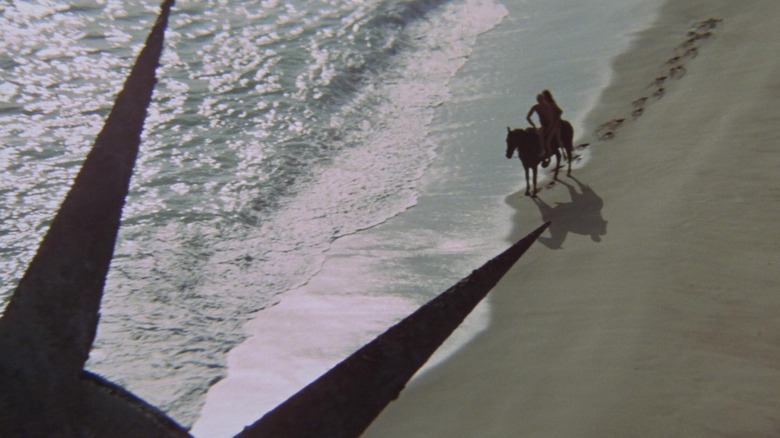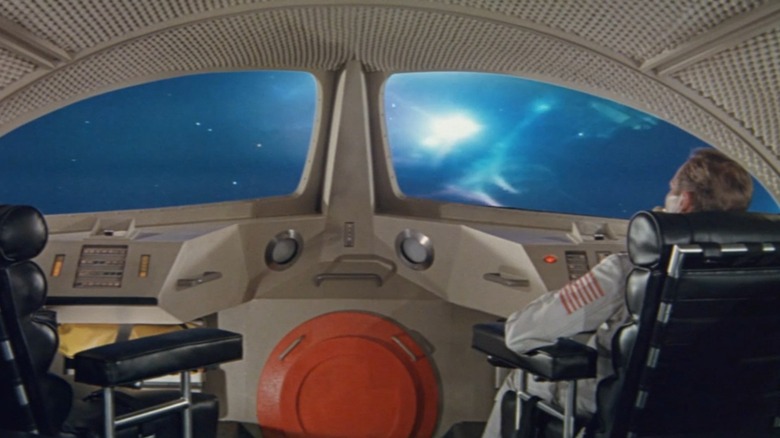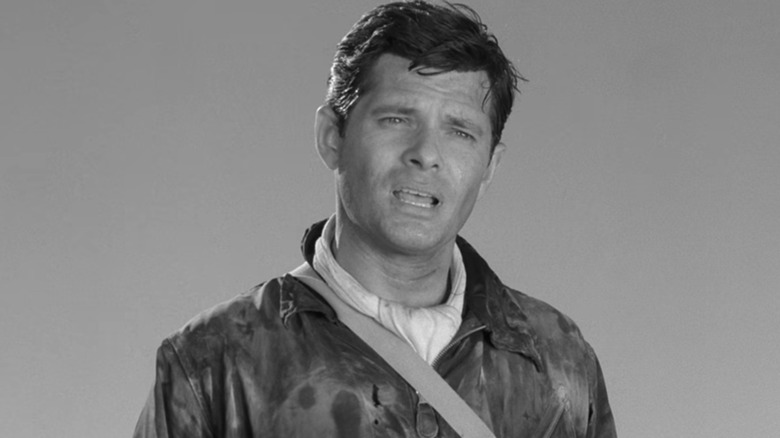The Twilight Zone Episode That Gave Planet Of The Apes Its Famous Twist Ending
When I was a kid, no movie ending scared me more than "Planet of the Apes." Granted, I was exposed to Tim Burton's poorly received update on the film before I ever saw the stunning ending of Franklin J. Schaffner's original, but the effect was the same both times: total shock, awe, and primal fear over the idea that our world may one day become wholly unrecognizable.
I was far from alone. A young Roger Ebert, just one year into his career as a critic, praised the film for its "thoroughly satisfactory surprise ending," while Pauline Kael commended the movie's ability to pull off its revelations, noting that its "construction is really extraordinary." The final scene of the film, in which an abstract monument in the sand is revealed to be none other than the Statue of Liberty, is both thrilling and existentially horrifying. Who could have ever guessed that Charlton Heston's space traveler George Taylor, flung through a wormhole into a strange world run by a complex hierarchy of apes, was actually on Earth all along?
From the Planet of the Apes to Reno, Nevada
Well, "Twilight Zone" fans might have guessed. The movie's twist ending bears a more-than-passing resemblance to an episode of Rod Serling's classic anthology series, "I Shot An Arrow Into the Air," which aired on CBS a full eight years before "Planet of the Apes" made it to theaters. The season 1 episode follows a group of astronauts who crash land on a desert planet and eventually turn on one another in a struggle over resources and leadership. When just one survivor, Dewey Martin's Officer Corey, is left, he heaves himself over a rocky crest to discover that he's not in outer space — but an hour or so drive away from Reno, Nevada.
Serling worked with screenwriter Michael Wilson on the "Planet of the Apes" script, which adapted Pierre Boulle's novel of the same name from five years earlier. According to an extensive authorship investigation shared by the Rod Serling Memorial Foundation, it took the better part of those five years for the pair to write the script, as several drafts of its ending can be found dated as far back as 1964. Boulle's story is much more in-depth in its discussion of the fall of humanity and rise of ape overlords, with one character uncovering an ancient human city and another describing the planet's backstory at length. The Serling and Wilson version of the story, though, chose to end on a wordlessly revealed twist — one that felt jaggedly emotional, deeply shocking, and so very "Twilight Zone."
Where did that twist ending really come from?
Though sources including Cinephilia Beyond say that Serling's "Planet of the Apes" ending was directly based on "I Shot An Arrow Into the Sky," the Serling Memorial Foundation investigation finds questions surrounding the movie's ending much more fraught. Serling's biographer Joel Engel, apparently credited the ending to Wilson, whose name the deep dive notes is the only one on the script at the Academy of Motion Picture Arts and Sciences' official library. Yet it's clear that throughout a painstaking drafting process, Serling came back to the idea of the twist ending again and again. The first mention of the Statue of Liberty seems to have come from Serling, who wrote that Thomas discovers a "giant metal arm" that prompts him to look at the Big Dipper in the sky, realizing all at once that he's on Earth.
Writing is a collaborative process, and while the final version of "Planet of the Apes" is likely a mixture of ideas from Wilson, Serling, and Boulle's book, someone else entirely was responsible for the "Twilight Zone" episode that shares the film's twist ending. That idea came from a woman named Madelon Champion, who apparently approached Serling with the idea. "Madelon Champion said to me, 'What would happen if three guys landed on what they thought was an asteroid and it turned out to be outside of Las Vegas? I paid five hundred dollars for that one on the spot,'" Serling shared in M.S. Zicree's book "The Twilight Zone Companion."
Serling had a penchant for dark, existential joke endings
Apparently, this was the first and only time Serling ever bought an idea from someone at random. It was a good one — while the end of the episode is a no-brainer for modern audiences with better knowledge of space travel, its impact is still strong. The chapter plays out like an extremely dark joke. Indeed, in the concluding voiceover, Serling calls it a "Practical joke perpetrated by Mother Nature and a combination of improbable events." It also has a whiff of a cautionary tale to it, as it wasn't the harsh elements that killed the crew but their inability to work together.
"The singular greatest evil of our time is prejudice," Serling told the L.A Times in 1967, ahead of the release of "Planet of the Apes" (per Cinephilia Beyond). He added, "In almost everything I have written there is a thread of this. Man's palpable need to dislike someone other than himself." It's a pattern we see repeating throughout Serling's work on "Twilight Zone" episodes like "I Shot An Arrow Into the Sky" and another "Apes"-esque chapter called "People Are Alike All Over." That dark social commentary is in the final version of "Planet of the Apes," too, no matter whose name ended up on the script.



